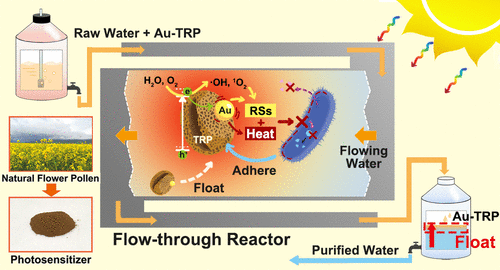当前位置:
X-MOL 学术
›
ACS ES&T Eng.
›
论文详情
Our official English website, www.x-mol.net, welcomes your feedback! (Note: you will need to create a separate account there.)
Flower Pollen-Based Photosensitization Process for Enhanced Solar Disinfection of Drinking Water: Reactor Design and Inactivation Mechanisms
ACS ES&T Engineering Pub Date : 2022-01-19 , DOI: 10.1021/acsestengg.1c00314 Zhuoyun Tang 1 , Ran Yin 2 , Wei Qu 1 , Huadan Liu 1 , Huijun Luo 1 , Dehua Xia 1, 3 , Yajing Huang 1 , Longfei Shu 1, 3 , Chun He 1, 3
ACS ES&T Engineering Pub Date : 2022-01-19 , DOI: 10.1021/acsestengg.1c00314 Zhuoyun Tang 1 , Ran Yin 2 , Wei Qu 1 , Huadan Liu 1 , Huijun Luo 1 , Dehua Xia 1, 3 , Yajing Huang 1 , Longfei Shu 1, 3 , Chun He 1, 3
Affiliation

|
Solar disinfection (SODIS) is a chemical-free, low-cost, and user-friendly approach to achieving Sustainable Development Goal No. 6 (SDG 6). Herein, a natural flower pollen-based photosensitizer was fabricated in a facile way and used to enhance the conventional SODIS process. Complete inactivation of five biohazards (Escherichia coli K-12, Spingopyxis sp. BM1-1, Bacillus subtilis spores, Enterococcus faecalis, and tetracycline-resistant E. coli) at their culturable or viable but nonculturable states was achieved by both batch reactors and a flow-through reactor with a standing separation–recycling system. Herein, microorganisms adhered to the photosensitizer’s surface due to electrostatic attraction and topological interactions. The photosensitizer induced the localized heating effect under solar irradiation, and a portion of microorganisms was inactivated by the photothermal effect. Meanwhile, abundant reactive species (•OH and 1O2) were generated and contributed to the photocatalytic inactivation of microorganisms. Synergism between the photothermal and photocatalytic processes enhanced the destruction of cell membranes and the penetration of reactive species. A comprehensive inactivation pathway was proposed and verified. The findings suggested that the natural flower pollen-based photosensitization process is promising to enhance the SODIS for effective disinfection, which assists rural and underdeveloped areas in achieving SDG 6.
中文翻译:

用于增强饮用水日光消毒的基于花粉的光敏化工艺:反应器设计和灭活机制
太阳能消毒 (SODIS) 是一种无化学物质、低成本且用户友好的方法,可实现第 6 号可持续发展目标 (SDG 6)。在此,一种基于天然花花粉的光敏剂以一种简便的方式制造,并用于增强传统的 SODIS 工艺。完全灭活五种生物危害物(大肠杆菌K-12、Spingopyxis sp. BM1-1、枯草芽孢杆菌孢子、粪肠球菌和耐四环素大肠杆菌)) 在它们的可培养或可行但不可培养的状态下,是通过间歇反应器和带有站立式分离-回收系统的流通式反应器实现的。在此,由于静电吸引和拓扑相互作用,微生物粘附在光敏剂的表面。光敏剂在太阳照射下产生局部加热效应,部分微生物被光热效应灭活。同时,丰富的活性物质(• OH 和1 O 2) 产生并有助于微生物的光催化灭活。光热和光催化过程之间的协同作用增强了细胞膜的破坏和活性物质的渗透。提出并验证了综合灭活途径。研究结果表明,基于天然花粉的光敏化过程有望增强 SODIS 的有效消毒效果,从而帮助农村和欠发达地区实现 SDG 6。
更新日期:2022-01-19
中文翻译:

用于增强饮用水日光消毒的基于花粉的光敏化工艺:反应器设计和灭活机制
太阳能消毒 (SODIS) 是一种无化学物质、低成本且用户友好的方法,可实现第 6 号可持续发展目标 (SDG 6)。在此,一种基于天然花花粉的光敏剂以一种简便的方式制造,并用于增强传统的 SODIS 工艺。完全灭活五种生物危害物(大肠杆菌K-12、Spingopyxis sp. BM1-1、枯草芽孢杆菌孢子、粪肠球菌和耐四环素大肠杆菌)) 在它们的可培养或可行但不可培养的状态下,是通过间歇反应器和带有站立式分离-回收系统的流通式反应器实现的。在此,由于静电吸引和拓扑相互作用,微生物粘附在光敏剂的表面。光敏剂在太阳照射下产生局部加热效应,部分微生物被光热效应灭活。同时,丰富的活性物质(• OH 和1 O 2) 产生并有助于微生物的光催化灭活。光热和光催化过程之间的协同作用增强了细胞膜的破坏和活性物质的渗透。提出并验证了综合灭活途径。研究结果表明,基于天然花粉的光敏化过程有望增强 SODIS 的有效消毒效果,从而帮助农村和欠发达地区实现 SDG 6。


























 京公网安备 11010802027423号
京公网安备 11010802027423号